[From the April 2010 issue of Arcadia Magazine (released February 27)]
Looking back 20 years ago to 1990, a video game company by the name of SNK teamed up with ALPHA DENSHI (ADK) to develop a video game console. That console was made for arcades, yet at the same time was completely compatible for home use. It was called the "NEOGEO," meaning "new land," and owns a significant chapter in the annals of 1990s video game history.
This article was written to commemorate the mighty NEOGEO's 20th anniversary, and also to reflect on the impact and success it has garnered through the years.
First of all, in order to distinguish between arcade and home consoles, I'd like to touch a bit on the Multi Video System (MVS).
Just as the name suggests, the MVS is capable of holding 6 ROM cartridges at once, and players are able to select any one of those 6 games to play. This was relatively uncommon back then (as most would eventually hold 4 ROM cartridges).
The MVS offered all kinds of features, but two of the most important features to shop owners were its "low cost" and "compact size."
A typical arcade machine back then would cost about 200,000 yen, but ROM cartridges for the NEOGEO were available for quite a bargain at tens of thousands yen each. This dramatic difference in price was a big deal to small business owners. And being able to put multiple cartridges in a single machine was also very popular with such owners, as it eliminated the need to take up space with a lot of bulky machines.
Due to its size advantage, the MVS was not limited to video arcades, as it began to pop up in many bookstores, candy shops, and supermarkets as well. The diverse selection of titles and space-saving merits offered by the MVS not only lead to successful sales, but also played a significant role in garnering strong support for lease development. This greatly reduced the financial risks associated with installing game machines, and eliminated some of the hurdles posed to operators by the required mechanical knowledge. In this manner, the MVS's roots were firmly planted throughout the country.
The "small arcades" deeply rooted in every corner of Japan began to grow more popular, primarily with the younger crowd. This was not only a commercial success, but contributed to the overall growth of the arcade industry.
Another significant feature is that software titles and specifications are identical for both arcade and home consoles, enabling absolute compatibility. I'll cover this in detail in the next section.
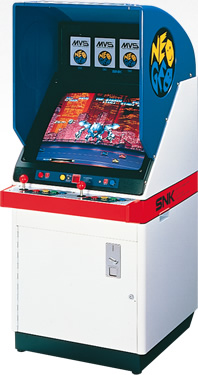
This 4-cart MVS machine is sure to stoke up 90s nostalgia for any serious gamer from back in the day. They could be found in candy shops, bookstores, and toy stores around the country. Generally 100 yen could get you two credits, even cheap enough for a kid to enjoy without going broke.
Now I'd like to get into some details about the "home console." To differentiate between the arcade's "MVS," it was named the "Advanced Entertainment System" (AES).
As mentioned before, NEOGEO spread the home console which having the identical spec to the arcade versions.
This unique and impressive quality also had its downsides however, primarily in the economic realm, as the AES was quite expensive for a home console. Due to this hurdle, the console was initially sold exclusively to rental video shops, where gamers who wanted to take the NEOGEO home for a spin had to rent whatever was available. This practice was not the norm for home game consoles, even back then, and is seen as quite an ambitious experiment. The AES was not sold to the public until 1991.
In 1990, the differences between arcade game and home console capabilities were quite glaring. A lot of arcade hits were ported to home consoles back then, but these ports could never compare to the originals in quality. To enjoy the quality of an arcade title at home, desperate gamers had to purchase the substrate and control panel of a full-size arcade machine, and tweak the wiring on their own. This required a lot of money, and time to achieve, and only the hardest of hardcore gamers could achieve such a feat.
Another special feature of the AES was the controller included with it -- an actual joystick. Today it's not hard to find arcade-caliber joysticks sold for home use, but back then such highly-efficient gaming equipment was virtually non-existent for home consoles due to profit concerns. The joystick included with the AES was designed with home use in mind, so the lever ball size, buttons, and board angle differed from that of the arcade machine, but it still impressed a lot of gamers with its high-quality finish and authentic response.
Another rarity for home consoles of the day was the external memory card, which could be used to transfer save data from your home system to the arcade machines (limited to certain types). Various game companies have tried similar arcade/home console linkage gimmicks, but the NEOGEO pioneered this concept with its versatile memory card in the early 90s.
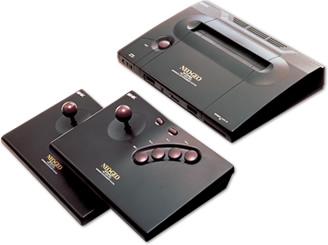
The AES was a home game console ahead of its time. The catch phrase of the day for this system was "Take home an awesome game."

Memory cards were sold separately. Level data etc. could be saved on one when the game was over.
Most launch titles for the NEOGEO were from platform holder, SNK, while the small remainder were ADK titles and a few tie-ups. Available genres included action shooters such as SNK's "NAM-1975" and "CYBER-LIP", or ADK's "MAGICIAN LORD" and "NINJA COMBAT". There were also a lot of sports titles available, such as "TOP PLAYER'S GOLF", "LEAGUE BOWLING", and "BASEBALL STARS PROFESSIONAL". Racing games, puzzle games, and quiz games often found in arcades were also available.
A major turning point for the NEOGEO came with the introduction of one-on-one fighting games in the early 90s. This movement had a huge impact on what the NEOGEO was about to become.
Although fighting games such as "FATAL FURY" and "ART OF FIGHTING" were among the NEOGEO's launch titles, and were quite popular at the time, they played very similar to action titles, and didn't offer the depth of a true fighting game.
However, all that changed with the introduction of "FATAL FURY 2" -- a title that offered the excitement of an authentic fighting game. With eight selectable characters, including all three from its predecessor, the battle system had been tuned up nicely with some interesting additions to the fight mechanics.
The developers also took advantage of the NEOGEO's power and impressive ROM capacity to create stunning animations, smooth character movement, and excellent graphics, generating an excitement among players that had never been achieved before. In no time at all this game became a smash hit, and its remarkable success increased awareness of the NEOGEO by leaps and bounds.
Games with a ROM capacity of over 100 megabits came on the scene at about this time, and the famous motto "THE 100 MEGA SHOCK!" was born. The impact of such an amazing capacity literally had gamers "shocked" back then.
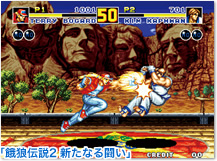
NEOGEO fighting games were known for their wild motions and exhilarating sense of speed.
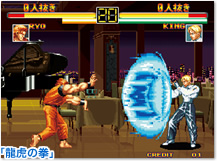
"ART OF FIGHTING" was the first 100-megabit title available.
Right off the bat, kids and adults alike were captivated by the cutting-edge gameplay and beautiful graphics offered by such a high-capacity ROM. The sequel to "FATAL FURY 2" was released as "FATAL FURY SPECIAL", which offered even more depth and exhilarating gameplay than its predecessor, ultimately sparking a new interest in the fighting game genre among gamers in the 1990s.
This wave of fighting game popularity triggered by "FATAL FURY 2" spawned the release of various other fighting games for the NEOGEO.
Sequels were released for "ART OF FIGHTING" as well, which became a popular series after the "FATAL FURY" games. The "ART OF FIGHTING" sequels really took advantage of the NEOGEO's zoom function to create vivid cutscenes, along with a powerful story, further impressing fans of the series. Another group of successful releases in the genre were the "SAMURAI SHODOWN" games, based on romance / period pieces set in Japan's Edo Period. These games added a new element to the genre by pitting characters against each other with weapons. These impressionable, weapon-wielding characters shined brightly in cutscenes and gameplay alike.
SNK's close partner ADK then released a sequel to "WORLD HEROS", with unique characters and an ambitious battle system. Implementation of this experimental system opened up several possibilities for future titles in the genre. At about this time, third parties other than ADK partnered with SDK adding more depth to the NEOGEO lineup.
Fighting games on the NEOGEO started heating up at this point, with developers competing almost recklessly at times blazing the fighting game frontier, and stoking the excitement of fans in the era of a new genre.
It is an undeniable fact that the NEOGEO's various fighting games were a major contributing force to the genre's development. This contribution was not limited to pioneering ideas and technological feats. New NEOGEO releases always had an element of surprise and excitement that kept gamers on their toes. The fun factor offered by each title, but also an expectation of the unexpected, is what propelled fighting games to greatness in the 1990s. And no other system drew in gamers in such a fashion than the NEOGEO.

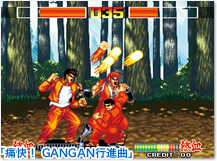
ADK had a close partnership with SNK. Various unique titles released by ADK shined bright as some of the best among the NEOGEO lineup.
When discussing the NEOGEO, one cannot help mentioning the appealing characters and settings found in its titles.
Terry Bogard from the "FATAL FURY" series broke away from the stereotypical hero image often used to this day. Back when a fighter was usually thought of as a seeker of truth or something similarly profound, this young American rebel with his wild appearance and over-the-top techniques, yelling "OK!" and throwing his cap to celebrate victory, generated a lot of curiosity. This characteristic became a staple of the series, and Terry Bogard grew into an icon for the NEOGEO's fighting game genre. As the genre grew, fighting game fanatics would imitate Terry Bogard's "cap throw" performance all over the world.
Another character of worldwide fame was Nakoruru from the "SAMURAI SHODOWN" series. With a costume design based on traditional Ainu clothing, sweet looks and personality, dainty figure, and unique fighting techniques with her loyal hawk, Nakoruru stole the hearts of male gamers from across the globe. Eventually her fame grew even beyond the initial circle of heavy gamers.
I'm sure a lot of people remember Nakoruru's image on a poster for the Mitaka City Water Department in 1994. Today it's not unlikely to see something like this, but back then, save a children's event, finding a video game or anime character on a public sign was virtually unheard of. This was a breakthrough for characters in the video game world. Some might even argue that using Nakoruru on a public notice has granted a form of "citizenship" to a game character.
The appeal of NEOGEO characters comes from a fusion of their fresh, nonconformist image with a standard, hero-like strength. But this new image alone wasn't enough to propel them to mainstream status, and promises alone won't get the attention of users. A combination of these two traits, being completely new, but at the same time maintaining the characteristics universal to all heroes, is what brought about this new standard of characters.
“The Future Is Now” was SNK's slogan back then, and as we can see in retrospect, the NEOGEO was truly ahead of its time.
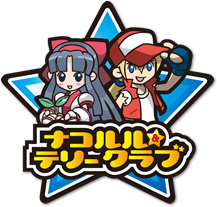
The two folks above are also found in SNK Playmore's social action organization, the "Nakoruru & Terry Club."
One thing important to remember about the impact of NEOGEO characters is the rise in popularity among female gamers, which ultimately led to a shift in strategy for video game arcades.
For the longest time, the "video arcade" was seen by the general public as a gathering place for hoodlums and shady characters. By the time the NEOGEO was popular, that negative public image had nearly faded, but stereotypes won't often die easily, and female gamers were still very reluctant to set foot in one.
A significant shift in events came with the release of "THE KING OF FIGHTERS" (KOF) series. As mentioned before, NEOGEO characters had drawn quite a large fan base, but the fans were overwhelmingly male. KOF changed all that. Kyo Kusanagi was the main character of the first title "KOF '94," and Iori Yagami was his rival in the next title "KOF '95." For the first time, female gamers started to develop more than just a light interest in the video game world.
Fangirls started learning about Kyo and Iori in video game magazines and other media, which had them falling in love with the characters and ultimately trekking to video arcades for the first time in droves. Watching "Kyo-sama" and "Iorin" do their thing on the screen had them mesmerized, and positive feedback came flooding into shops on comment cards.
This increase in female customers gave more of a "wholesome image" to the video arcade in general, forcing arcade operators to seriously consider this new bracket of customers. Kyo and Iori had a significant effect on opening the doors of the previously male-dominated "video arcade" to the opposite sex.
The NEOGEO caused a major shift in the video arcade scene.
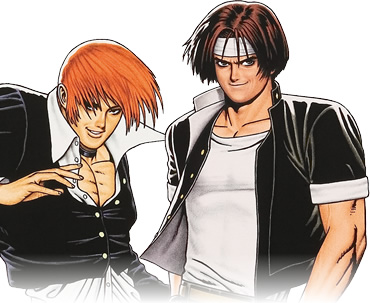
You can thank me for the influx of girls into arcades since my debut in KOF '95. It's actually the rivalry between Kyo and Iori that really got things rolling. Character relationships were a specialty of NEOGEO games, another aspect of its appeal to gamers.
3D graphics took the game world by storm in the mid 90s. Titles using 3D technologies significantly altered the direction of video game history. Multiple companies had started selling next-gen consoles at this time, and new buzz words such as "polygons" and "texture mapping" had game fans pumped for something new and innovative. This was a major turning point for arcade games and home consoles alike.
The NEOGEO's specialty 2D pixel graphics became more refined as a result of this phenomenon. In 1996, "motion capture" was already a part of the 3D gaming technology lingo (which essentially means to transfer the movements of actual humans to a computer). This technology would be used to create an ambitious title like "ART OF FIGHTING 3", which was actually a 2D game.
A good example of cutting-edge pixel technology at that time was "METAL SLUG". The gritty smell of iron and gun smoke on a battlefield in the near future, along with the comical antics of the unique characters, are what gave this game its appeal. Over-the-top details combined with clever simplicity gave this game a sense of contradictory beauty, hitting game fans already enamored with the development of 3D technologies like a brick.
A well-received sequel to "METAL SLUG" was released in 1998 and even today the new additions to the series continued to sell well, establishing it as a timeless favorite among SNK's offerings.
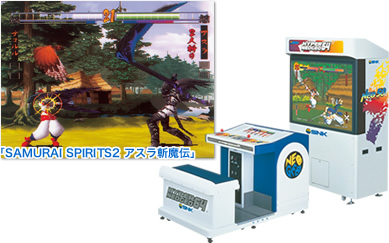
SNK developed the innovative "Hyper NEOGEO 64" during the 3D era, releasing additions to their wildly-successful "SAMURAI SHODOWN" series and "FATAL FURY" series.
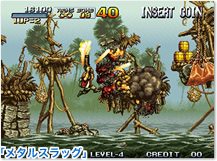
"METAL SLUG" is a representation of pixel graphics at their finest. Character expressions, and the beautiful, intricate graphics used down to the smallest detail for backgrounds are even impressive by today's standards.
New software continued to be released for the NEOGEO into the late 90s. SNK announced that KOF 2000 would be their final addition to the series, and that considerable cuts would be made to the NEOGEO's arcade releases.
In 2001, SNK called it quits.
Fans of SNK and the NEOGEO lamented the fact that they'd most likely never come across a new release for the system again.
Through a series of twists and turns, a company called Playmore (now called SNK Playmore) was established by a number of former SNK employees, who acquired SNK's copyrights and released KOF 2001. This sudden, dramatic rebirth of an SNK favorite caught fans by surprise. For about three years after that, new titles for their beloved NEOGEO came out one after another.
In the final days of SNK's arcade releases, the system and ROM were combined into one unit, such as with "SNK vs. Capcom: SVC Chaos". This was partially due to the fact that new ROMs would no longer play on the old MVS. It is one of the episodes to symbolize the NEOGEO’s long life as the arcade machine.
The NEOGEO released "SAMURAI SHODOWN V SPECIAL" in 2004, and since then there aren’t any new titles for it.
But the name "NEOGEO" lives on in the minds of video game enthusiasts everywhere, and has become a lasting symbol of SNK's quality products.
20 years ago, employees at SNK had big dreams of a "new land," which eventually made big waves in the gaming industry, and is still recognized to this day as a console ahead of its time
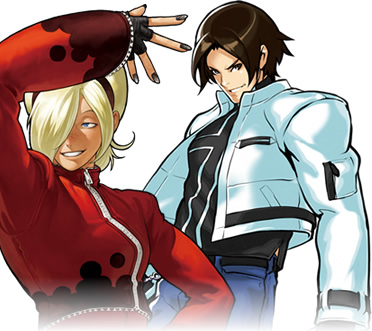
The characters brought to life by the NEOGEO live on to this day brilliantry.

















